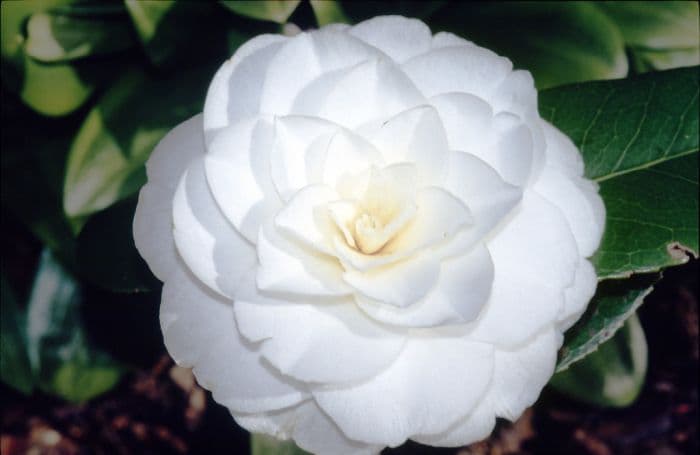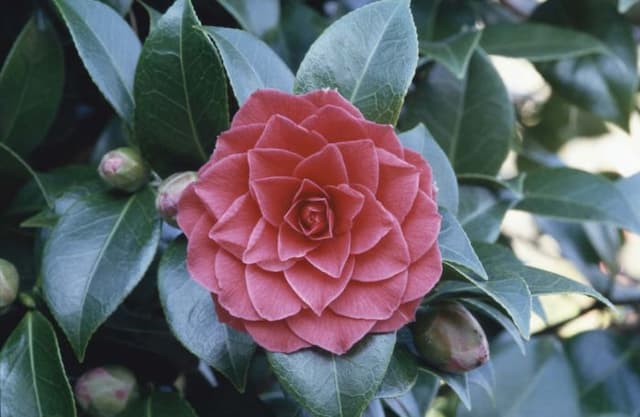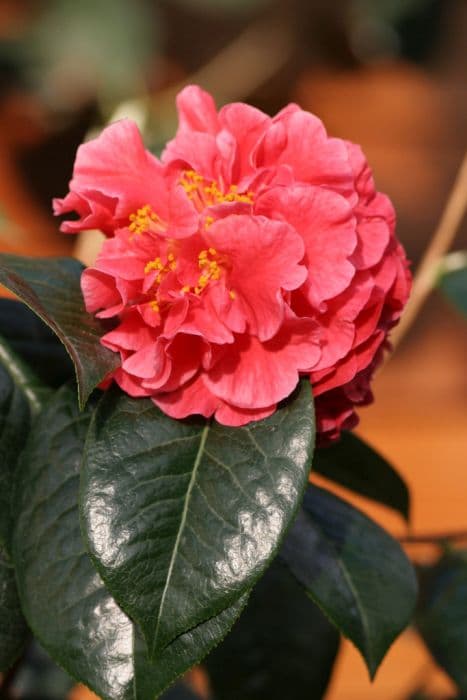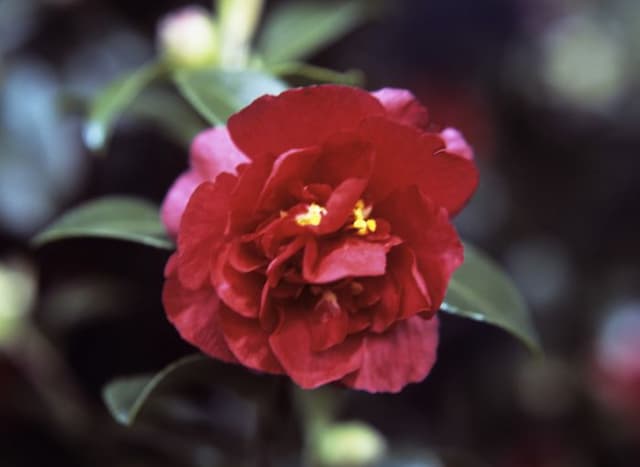Japanese Camellia Camellia japonica 'Alba Plena' (d)

ABOUT
The Camellia japonica 'Alba Plena' is a captivating plant known for its showy flowers that grace gardens with their pristine beauty. It flaunts an abundance of fully double, white blossoms that bear a remarkable resemblance to small roses. Each flower is a collection of numerous overlapping petals, arranged in a symmetrical fashion that creates a dense, textured bloom. The petals of the 'Alba Plena' exhibit a waxy sheen, contributing to their elegance and visual appeal. At the heart of each flower, the tightly packed petals obscure any view of the plant's reproductive structures, adding to the overall lushness of the blooms. Surrounding the flowers are glossy, rich green leaves that provide a perfect backdrop to the striking white of the blooms. The leaves are oval-shaped, with a smooth surface and a leathery texture, coming to a subtle point at the ends. Their edges are delicately serrated, giving them a finely toothed appearance. Together, the luxurious white blooms and lustrous foliage make the Camellia japonica 'Alba Plena' a desirable specimen among plant enthusiasts, offering a classic yet dramatic aesthetic to any planting area where it is situated. Its flower form and coloration are particularly appreciated during the cooler months when such vibrant blooms are a delightful rarity.
About this plant
 Names
NamesFamily
Theaceae
Synonyms
Japanese Camellia, Common Camellia, Rose of Winter
Common names
Camellia japonica f. plena (d), Camellia japonica var. plena (d)
 Toxicity
ToxicityTo humans
The plant commonly known as Japanese camellia is not toxic to humans. There are no known toxic effects from ingesting any part of the Japanese camellia.
To pets
Japanese camellia is also non-toxic to pets. Ingesting parts of the plant should not cause any symptoms of poisoning in animals such as dogs or cats. There are no known toxic consequences from pets consuming any part of the Japanese camellia.
 Characteristics
CharacteristicsLife cycle
Perennials
Foliage type
Evergreen
Color of leaves
Green
Flower color
White
Height
6-12 feet (1.8-3.6 meters)
Spread
6-10 feet (1.8-3 meters)
Plant type
Shrub
Hardiness zones
7
Native area
Japan
Benefits
 General Benefits
General Benefits- Ornamental Value: The Camellia japonica 'Alba Plena', commonly known as the Japanese camellia, has beautiful, fully double white flowers that add aesthetic appeal to gardens and landscapes.
- Long Blooming Season: This plant has a long flowering period, typically from late winter to early spring, bringing color and interest to the garden during a time when few other plants are in bloom.
- Ease of Cultivation: Japanese camellias are known for being relatively easy to cultivate in the right conditions, requiring well-drained, acidic soil and some shade.
- Versatility: The plant can be used in various landscaping applications, such as specimen planting, hedges, foundation plantings, or container gardening.
- Drought Tolerance: Once established, Camellia japonica 'Alba Plena' demonstrates a degree of drought tolerance, needing less frequent watering than many other ornamentals.
- Evergreen Foliage: It has glossy, evergreen leaves that provide year-round interest and structure to the garden, even when the plant is not in bloom.
- Attracts Pollinators: Although not its main feature, the flowers can attract pollinators such as bees during their blooming season.
 Medical Properties
Medical PropertiesThis plant is not used for medical purposes.
 Air-purifying Qualities
Air-purifying QualitiesThis plant is not specifically known for air purifying qualities.
 Other Uses
Other Uses- Camellia japonica 'Alba Plena' can be used as a natural dye for fabrics, harnessing its petals for delicate pink hues.
- The petals of the Japanese Camellia can be added to bathwater for a luxurious, fragrant soak, potentially leaving the skin lightly perfumed and soft.
- These plants are often used in Bonsai cultivation, offering an aesthetic pastime for enthusiasts looking to sculpt and maintain miniature trees.
- Culinary adventurous chefs can crystallize Japanese Camellia petals for use as edible decorations on cakes and desserts.
- Japanese Camellia wood, being dense and smooth, is sometimes used to craft small objects like combs or intricate pieces of jewelry.
- The fallen petals of the Japanese Camellia can be scattered on paths or walkways to create a romantic, picturesque landscape.
- Ink made from the petals of Japanese Camellia can be used for artistic purposes, giving paintings or writings a unique, organic touch.
- Japanese Camellia flowers are used in fashion, often worn as hair accessories in traditional East Asian hairstyles to add natural elegance.
- Petals from the Japanese Camellia can be pressed and included in homemade paper, adding flecks of color and texture to the finished product.
- Japanese Camellia can be utilized in photography and film as a symbol of purity and perfection, due to its pristine, white blooms.
Interesting Facts
 Feng Shui
Feng ShuiThe Camellia is often associated with bringing positive energy and is used in Feng Shui to symbolize love, affection, and admiration. It can be placed in the southwest area of a garden or home to enhance the love and marriage corner according to Feng Shui bagua map, supporting relationships and encouraging a flourishing love life.
 Zodiac Sign Compitability
Zodiac Sign CompitabilityThe Camellia is not used in astrology practice.
 Plant Symbolism
Plant Symbolism- Admiration: The 'Alba Plena' is a variety of Camellia often associated with deep respect and admiration, reflecting the awe it inspires with its perfect, full blooms.
- Perfection: Its immaculate white petals often symbolize perfection, making it an ideal gift for someone who is viewed as flawless in the eyes of the giver.
- Love: Camellias in general are symbols of love and affection. The 'Alba Plena', with its pristine white flowers, can represent pure and refined love.
- Longevity: The robust nature of the Camellia plant, combined with its evergreen qualities, conveys a message of long-lasting life and enduring spirit.
- Faithfulness: The plant's ability to bloom year after year symbolizes faithfulness and the idea of staying true over time.
 Water
WaterThe Japanese camellia 'Alba Plena' benefits from consistent moisture but should not be allowed to sit in waterlogged soil. Water the plant deeply to encourage deep root growth, providing about 1 to 1.5 gallons of water per week during active growth in the spring and summer. During fall and winter, reduce watering to about half a gallon a week unless the soil is very dry. Always check the top inch of soil for dryness before watering; if it's dry to the touch, it's time to water. In high heat or windy conditions, you may need to water more frequently to maintain soil moisture.
 Light
LightThe Japanese camellia 'Alba Plena' prefers bright, indirect light or partial shade. Avoid direct afternoon sun, which can scorch the leaves. A spot that receives morning sun but is shaded during the hottest part of the day is ideal. If grown indoors, place near a window with filtered light or use a sheer curtain to diffuse strong sunlight.
 Temperature
TemperatureThe Japanese camellia 'Alba Plena' thrives in temperatures ranging from 60 to 75 degrees Fahrenheit, making it suitable for growing outdoors in USDA hardiness zones 7 to 9. The plant can tolerate minimum temperatures as low as 10 degrees Fahrenheit but will need protection from frost. For optimal growth, keep the plant away from cold drafts and sudden temperature changes.
 Pruning
PruningPrune the Japanese camellia 'Alba Plena' to maintain its shape and to remove any dead or damaged wood, as well as to promote airflow and prevent disease. The best time to prune is after the flowering season has ended, typically in late winter or early spring before new growth begins. Pruning should be done sparingly, as this plant blooms on old wood; excessive pruning can reduce the number of flowers.
 Cleaning
CleaningAs needed
 Soil
SoilThe Japanese Camellia 'Alba Plena' flourishes in acidic soil with a pH of 5.5 to 6.5. For optimum growth, mix 50% acidic compost with 50% pine bark and peat moss to create a well-draining, fertile soil mix.
 Repotting
RepottingJapanese Camellias like 'Alba Plena' should typically be repotted every 2 to 3 years to refresh the soil and provide room for root growth, ideally in the spring just before new growth begins.
 Humidity & Misting
Humidity & MistingCamellias, including 'Alba Plena', prefer high humidity levels, ideally between 40% to 60%. These conditions help mimic their natural humid forest habitats and encourage healthy growth and blooms.
 Suitable locations
Suitable locationsIndoor
Grow 'Alba Plena' indoors in bright, indirect light and high humidity.
Outdoor
Place 'Alba Plena' outdoors in partial shade and sheltered from strong winds.
Hardiness zone
7-9 USDA
 Life cycle
Life cycleCamellia japonica 'Alba Plena', commonly known as the Japanese camellia, begins its life cycle when a seed falls into fertile, well-draining soil, germinating to produce a small seedling. This seedling grows through a juvenile phase where it develops its root system and foliage but does not flower. After a few years, the plant reaches maturity, and the adult phase is marked by the appearance of lush, glossy evergreen leaves and large, double white flowers which typically bloom between winter and spring. The blossoms give way to seed pods that, once mature, release seeds to initiate a new generation. The Japanese camellia can continue to grow and flower for many years, often several decades, with some specimens living over a century. As the plant ages, it may enter a senescence phase where growth slows, and flowering may decrease before the plant eventually dies.
 Propogation
PropogationPropogation time
Spring-Early Summer
Camellia japonica 'Alba Plena', commonly known as the Japanese camellia, is most effectively propagated by semi-hardwood cuttings. The ideal time for this method is in late summer, after the current year's growth has started to mature but still retains some flexibility. To propagate, select healthy semi-hardwood cuttings of about 4 to 6 inches (10 to 15 cm) long, making sure each cutting has several leaf nodes. The lower leaves should be removed and the cut end dipped in rooting hormone to encourage root development. These cuttings are then inserted into a mixture of sand and peat or a well-draining potting mix, ensuring at least one or two nodes are buried. It is important to maintain high humidity around the cuttings, which can be achieved by covering them with a plastic bag or placing them in a misting chamber. With proper care, the cuttings will develop roots in several weeks, after which they can be gradually acclimatized to less humid conditions before potting individually.









